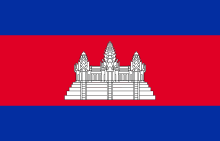Portal:Asia

 Asia (/ˈeɪʒə/ ⓘ AY-zhə, UK also /ˈeɪʃə/ AY-shə) is the largest continent in the world by both land area and population. It covers an area of more than 44 million square kilometers, about 30% of Earth's total land area and 8% of Earth's total surface area. The continent, which has long been home to the majority of the human population, was the site of many of the first civilizations. Its 4.7 billion people constitute roughly 60% of the world's population. Asia shares the landmass of Eurasia with Europe, and of Afro-Eurasia with both Europe and Africa. In general terms, it is bounded on the east by the Pacific Ocean, on the south by the Indian Ocean, and on the north by the Arctic Ocean. The border of Asia with Europe is a historical and cultural construct, as there is no clear physical and geographical separation between them. It is somewhat arbitrary and has moved since its first conception in classical antiquity. The division of Eurasia into two continents reflects East–West cultural, linguistic, and ethnic differences, some of which vary on a spectrum rather than with a sharp dividing line. A commonly accepted division places Asia to the east of the Suez Canal separating it from Africa; and to the east of the Turkish Straits, the Ural Mountains and Ural River, and to the south of the Caucasus Mountains and the Caspian and Black seas, separating it from Europe. China and India traded places as the largest economies in the world from 1 to 1800 CE. China was a major economic power for much of recorded history, with the highest GDP per capita until 1500. The Silk Road became the main east–west trading route in the Asian hinterlands while the Straits of Malacca stood as a major sea route. Asia has exhibited economic dynamism as well as robust population growth during the 20th century, but overall population growth has since fallen. Asia was the birthplace of most of the world's mainstream religions including Hinduism, Zoroastrianism, Judaism, Jainism, Buddhism, Confucianism, Taoism, Christianity, Islam, Sikhism, as well as many other religions. (Full article...) Featured article The climate of India consists of a wide range of weather conditions across a vast geographic scale and varied topography. Based on the Köppen system, India hosts six major climatic sub types, ranging from arid deserts in the west, alpine tundra and glaciers in the north, and humid tropical regions supporting rain forests in the southwest and the island territories. Many regions have starkly different microclimates, making it one of the most climatically diverse countries in the world. The country's meteorological department follows the international standard of four seasons with some local adjustments: winter (December to February), summer (March to May), monsoon or rainy season (June to September), and a post-monsoon period (October and November). India's geography and geology are climatically pivotal: the Thar Desert in the northwest and the Himalayas in the north work in tandem to create a culturally and economically important monsoonal regime. As Earth's highest and most massive mountain range, the Himalayas bar the influx of frigid katabatic winds from the icy Tibetan Plateau and northerly Central Asia. Most of North India is thus kept warm or is only mildly chilly or cold during winter; the same thermal dam keeps most regions in India hot in summer. The climate in South India is generally warmer, and more humid due to its coastlines. However some hill stations in South India such as Ooty are well known for their cold climate. (Full article...)Selected Country Cambodia, officially the Kingdom of Cambodia, is a country in Southeast Asia on the Indochinese Peninsula, spanning an area of 181,035 square kilometres (69,898 square miles), bordered by Thailand to the northwest, Laos to the north, Vietnam to the east, and the Gulf of Thailand to the southwest. The capital and most populous city is Phnom Penh. In 802 AD, Jayavarman II declared himself king, uniting the warring Khmer princes of Chenla under the name "Kambuja". This marked the beginning of the Khmer Empire. The Indianised kingdom facilitated the spread of first Hinduism and then Buddhism to Southeast Asia and undertook religious infrastructural projects throughout the region. In the fifteenth century, Cambodia experienced a decline of power, and in 1863, it became a protectorate of France. After a period of Japanese occupation during the Second World War, Cambodia gained independence in 1953. The Vietnam War extended into the country in 1965 via the Ho Chi Minh and Sihanouk trails. A 1970 coup installed the US-aligned Khmer Republic, which was overthrown by the Khmer Rouge in 1975. The Khmer Rouge ruled the country and carried out the Cambodian genocide from 1975 until 1979, when they were ousted in the Cambodian–Vietnamese War. The Vietnamese-occupied People's Republic of Kampuchea became the de facto government. Following the 1991 Paris Peace Accords which formally ended the war with Vietnam, Cambodia was governed by a United Nations mission (1992–93). The UN withdrew after holding elections in which around 90% of the registered voters cast ballots. The 1997 coup d'état consolidated power under Prime Minister Hun Sen and the Cambodian People's Party (CPP). While constitutionally a multi-party state, CPP dominates the political system and dissolved its main opposition party in 2017, making Cambodia a de facto one-party state. (Full article...)Featured biographyAyumi Hamasaki (浜崎あゆみ, Hamasaki Ayumi, born October 2, 1978) is a Japanese singer, songwriter, record producer, actress, model, spokesperson, and entrepreneur. By 2002, Hamasaki had earned the nickname "Empress of J-pop" due to her popularity in Japan and throughout Asia, as well as being referred to as "the voice of the lost generation". Due to her success and relevance throughout her career, she is considered one of the top solo female artists of the Heisei era for her influence on the music industry and various fashion trends. Born and raised in Fukuoka, Fukuoka Prefecture, Hamasaki moved to Tokyo at 14 in 1993 to pursue a career in singing and acting. In 1998, Hamasaki released her debut single "Poker Face" and debut major-label album A Song for ××. The album debuted at the top of the Oricon charts and remained there for five weeks, selling over a million copies. This rapid rise to fame is typically attributed to her insightful style of lyric-writing in contrast to her young age; this would continue to be a defining aspect of her work, listeners praising her poetic way of conveying relatable subjects. Her next ten albums shipped over a million copies in Japan, with her third, Duty, selling nearly three million. A Best, her first compilation album, further established her position as a crowning artist with more than four million copies sold in Japan. It was at this time that she represented more than 40% of her record label's income. (Full article...)General imagesThe following are images from various Asia-related articles on Wikipedia. Featured picture Credit: Pratheepps The Toda people are a small pastoral tribe of less than 1,000 people who reside in the Nilgiri hills of Southern India. Shown here is a typical Toda hut, about 3 m (10 ft.) high, 5.5 m (18 ft.) long and 2.7 m (9 ft.) wide. They are built of bamboo fastened with rattan and thatched. The hut has only a tiny (about 0.9 x 0.9 m, 3 x 3 ft.) entrance at the front, which serves as protection from wild animals.
Did you know...
Updated: 6:33, 14 February 2024 In the news
Related portalsMajor Religions in Asia Middle East Central Asia and Surroundings Indian Subcontinent Southeast Asia East Asia Selected panorama
Bangalore, is the capital of the Indian state of Karnataka. It has a population of over ten million, making it a megacity and the third-most populous city and fifth-most populous urban agglomeration in India. TopicsCategoriesAssociated WikimediaThe following Wikimedia Foundation sister projects provide more on this subject:
More portalsShortcuts to this page: Asia portal • P:ASIA Purge server cache |





























































































